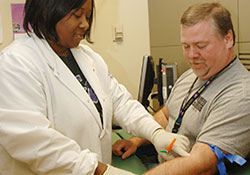Office of Research & Development |
 |

VA Research Currents archive
Posted December 9, 2013
Doctors nationwide are changing the way they look at cholesterol and heart disease thanks to a groundbreaking shift in cholesterol-treatment guidelines spurred in part by VA researchers Drs. Rodney Hayward and Harlan Krumholz.

Blood tests for cholesterol levels take place millions of times each day in U.S. medical offices. Under new guidelines, doctors are now advised to focus less on specific numerical targets for prescribing statin drugs to lower LDL cholesterol. Here, a Veteran gets his blood drawn at the Central Arkansas VA Healthcare System. (Photo by Anita Plummer)
The American Heart Association and the American College of Cardiology's new guidelines are a major shift from traditional thinking on ways to prevent cardiovascular disease. For decades doctors have prescribed statins to patients with high cholesterol, particularly when it comes to LDL, or "bad," cholesterol. Statin drugs work by blocking a key enzyme the body uses to produce cholesterol. What's more, solid clinical evidence supports their ability to cut the risk of heart disease.
Researchers found that despite years of doctors' prescribing the drugs, there was little evidence that one cholesterol number is necessarily better when determining how helpful medication treatment will be in preventing heart disease. The change occurred when a committee attempted to identify the target LDL level for patients. Hayward, of the University of Michigan, and Krumholz, a cardiologist at Yale, challenged the predominant thinking by asking what proof there was that a lower LDL level improved a patient's chances of avoiding heart disease.
Hayward and Krumholz have spent years studying the effects of LDL levels and statin therapy on heart disease. They found that while statins lowered the overall risk of heart disease, cholesterol level played a much smaller role than expected among patients with the same overall heart disease risk.
Hayward and Krumholz argued that doctors had become so fixated on treating a number that they had lost sight of the larger goal, which was to prevent heart disease.
The committee, influenced by a number of studies Hayward and Krumholz had published, determined that while lower LDL levels were generally better, there was no magic cholesterol number that patients and doctors should strive toward. That, combined with the rising numbers of Americans being put on cholesterol-lowering drugs, with sometimes worrisome side effects, prompted the committee to revise the way patients should be evaluated.
Now, based on the new guidelines, doctors are advised to no longer prescribe statins and other similar drugs based on cholesterol levels alone. Patients already taking medication are no longer urged to monitor their cholesterol numbers. In fact, the guidelines don't even establish a target number for LDL. Rather, they advise patients to look at statins the same way they might a daily aspirin to reduce their risk of heart attack.
Instead of quickly prescribing drugs, the guidelines suggest doctors use a formula to calculate a person's risk of having a heart attack over the next 10 years. If that risk is 7.5 percent or higher, doctors should prescribe statins, something Hayward and Krumholz disagree with. "At 7.5 percent, it may be appropriate for providers to discuss the pros and cons of treatment with their patients," said Hayward, who considers the 7.5 percent threshold inappropriate. "A 12.5 to 15 percent risk might be a better range for taking a statin." There are also several high-risk groups who should get statins regardless of their score on the formula. They include people genetically predisposed to super-high cholesterol (LDL over 190), and patients between ages 40 to 75 with diabetes or a history of heart disease. However, under the new guidelines, these patients no longer have to aim toward a specific cholesterol number.
VA had already reviewed its policies last year based on Hayward and others' research and dropped its LDL targets, according to Dr. John Rumsfeld, the VA's national director of cardiology.
"It's a shift," Rumsfeld told the New York Times last month, "but I would argue that it is not a radical change but is a course correction."